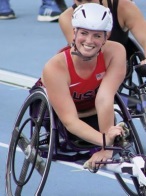
PLAY BY EAR: A group of children play with Rhapsody® outdoor musical instruments. Many children who are deaf or hard-of-hearing are drawn to musical play features and use their other senses to enjoy them.
More thought is also being put into how deaf and hard-of-hearing kids experience playgrounds.
Open spaces and wide walkways, for example, make it easier for kids who are deaf to communicate with sign language, which typically requires more space than spoken language. An open layout and easy-to-reach high point that overlooks a playground can also give kids with hearing disabilities greater spatial awareness of the area and help them “read” activities.
If your child wears a cochlear implant, you’re probably used to going out of your way to protect it. At playgrounds, that means avoiding plastic slides, which generate static that can damage the expensive device. But with a roller, concrete or stainless-steel slide, your child can enjoy going down a slide without worrying about static buildup.
Some inclusive play elements for kids with hearing disabilities may even surprise you. For example, deaf and hard-of-hearing
kids can be drawn to musical play features like bells. The kids may not hear the bells ring, but they can enjoy them with their other senses, like watching them shake or feeling them vibrate.
HOW YOU CAN HELP
So, how can you make your local playgrounds more inclusive for kids with vision and hearing disabilities? The best thing you can do is be a good advocate.
"By working together, you'll engage more of the community and get more dedicated resources to create an inclusive space."
That begins by being informed about inclusive play. Think about who will use a playground and what inclusion means for them. For example, get local ability demographics. They can help you understand your local disabled community so a playground can be designed to their unique needs.
Inclusive play features should also be woven into a playground in an intentional way. Otherwise, kids with disabilities can end up alone in isolated areas of play. What’s nice about
features like colorful stairs, roller slides and musical devices is that they can be integrated throughout a playground. They make play more inclusive for everyone. But they can be enjoyed by anyone.
Finally, use the power of positivity. Work with your city officials to inform them of your child's unique needs and offer your help. By working together, you'll engage more of the community and get more dedicated resources to create an inclusive space.
A group of students at Glen Lake Elementary School in Minnesota are a shining example of what a little initiative can do. The students wanted their fellow classmates with disabilities to be able to play on the school's playground just like them. They raised funds however they could and not only hit but exceeded their goal of raising $300,000 to make the playground more inclusive. And now, they've set a goal to make more school playgrounds in their community inclusive.
PLAY FOR ALL
On the playground, innovation can be an invitation – to play, to learn, to grow. To have the same experience as everyone else. By continuing to evolve playground designs to address the needs of kids with vision and hearing disabilities, playgrounds can be what they should be – places where every kid can have fun. •
ABOUT THE AUTHOR

Jill Moore is a Inclusive Play Specialist at Landscape Structures. She uses her lived experience as a wheelchair user to help inform intentional design practices to create truly inclusive playgrounds including sensory diverse environments, designing for the blind—low vision—deaf—or hard of hearing child, and retrofitting existing playgrounds for adaptive recreation. She brings the voice of the disabled community and inclusive design practices into the product-development process at Landscape Structures. With a specific focus on merging lived experience with universal design principles, Jill promotes and educates audiences on the importance of integrating inclusion in play and bringing people with disabilities into the conversation. As an accredited educational presenter — both in the classroom and the playground — play has become her full-time role. During her lifetime, Jill has represented Team USA as a multi-sport athlete, bringing perspective on the importance of recreation and how imperative equitable access to play is for all.